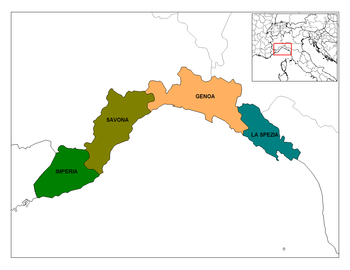Liguria: Difference between revisions
Undid two revisions by 65.254.5.134 (talk) |
ugly turn of phrase |
||
| Line 24: | Line 24: | ||
==Geography== |
==Geography== |
||
[[Image:Alta via.jpg|200px|thumb|left|Alta Via dei Monti Liguri]] |
[[Image:Alta via.jpg|200px|thumb|left|Alta Via dei Monti Liguri]] |
||
Liguria borders [[France]] to the west, [[Piedmont (Italy)|Piedmont]] to the north, and [[Emilia-Romagna]] and [[Tuscany]] to the east. It lies on the [[Ligurian Sea]]. The coastal strip forms the [[Italian Riviera]]; further inland are the Ligurian [[Alps]], on the west, and the Ligurian [[Apennine Mountains|Apennines]] on the east. |
Liguria borders [[France]] to the west, [[Piedmont (Italy)|Piedmont]] to the north, and [[Emilia-Romagna]] and [[Tuscany]] to the east. It lies on the [[Ligurian Sea]]. The coastal strip forms the [[Italian Riviera]]; further inland are the Ligurian [[Alps]], on the west, and the Ligurian [[Apennine Mountains|Apennines]] on the east. Despite the high population density, woods cover half of the total area. The Ligurian coast enjoys a typical [[mediterranean climate]], compared to the semi-[[continental climate]] of the [[Po River|Po]] valley to the north; in January, Genoa records an average temperature of about 8-10°C, with no frost, which can occur only in the mountainous interior. Summer averages about 25-30°C. |
||
Rainfall can be very abundant at times; mountains very close to the coast create an [[orographic]] effect, so Genoa can see up to 2000 mm of rain in a year; other areas instead show the normal values of the Mediterranean area (500-800 mm). |
Rainfall can be very abundant at times; mountains very close to the coast create an [[orographic]] effect, so Genoa can see up to 2000 mm of rain in a year; other areas instead show the normal values of the Mediterranean area (500-800 mm). |
||
Revision as of 09:31, 10 October 2008
44°27′20″N 8°44′5″E / 44.45556°N 8.73472°E Template:Infobox Region of Italy
Liguria is a coastal region of north-western Italy, the third smallest of the Italian regions. Its capital is Genoa. It is a popular region with tourists for its beautiful beaches, picturesque little towns, and food; Italy's world famous pesto sauce is originally from this region.
Geography

Liguria borders France to the west, Piedmont to the north, and Emilia-Romagna and Tuscany to the east. It lies on the Ligurian Sea. The coastal strip forms the Italian Riviera; further inland are the Ligurian Alps, on the west, and the Ligurian Apennines on the east. Despite the high population density, woods cover half of the total area. The Ligurian coast enjoys a typical mediterranean climate, compared to the semi-continental climate of the Po valley to the north; in January, Genoa records an average temperature of about 8-10°C, with no frost, which can occur only in the mountainous interior. Summer averages about 25-30°C. Rainfall can be very abundant at times; mountains very close to the coast create an orographic effect, so Genoa can see up to 2000 mm of rain in a year; other areas instead show the normal values of the Mediterranean area (500-800 mm).
Liguria is divided into four provinces:
History



Liguria is a very old name, dating back to pre-Roman times. Ancient Ligures settled the Mediterranean coast from Rhône to Arno, but later Gallic migration mixed and produced the Gallo-Ligurian culture. The region was officially subdued and colonised by the Roman Republic during the 2nd century BC. During the Middle Ages, Genoa gradually gained control of most of Liguria, which shared most of the city's history, and, with a few breaks in the 15th and early 16th century when the area was under either Milanese or French control, the Republic of Genoa ruled the area until 1796, when the French Revolutionary general Napoleon Bonaparte reorganized the area into the Ligurian Republic. The Ligurian Republic proved short-lived, however, and was annexed by France in 1805. Following the end of the Napoleonic Wars in 1815, the area was annexed by the Kingdom of Sardinia.
Economy

The Ligurian economy is based on tourism, olive oil production, winemaking, fisheries, and a different industrial sectors (yacht construction and maintenance, cruise liner building, military shipyards, glass- and ceramics-making, slate extraction and manufacturing, railroad carriage and locomotive building, oil refineries, aviation) mainly concentrated in Genoa and the Province of Savona. Steel, once a major industry in the 50s and 60s is being phased out after the late 70s and 80s crisis, as Italy is moving away from heavy industry to pursue more technologically advanced "light" industrial revolutions.
Politics
In Medieval and Renaissance times the then city states of Liguria were controlled by merchant families. Genoa was then run by the powerful merchant families, prominently the Adorno and the Campofregoso.
Demographics




Due to a severe economic crisis in the '80s and '90s Liguria lost 200,000 inhabitants, but after the economic recovery in the late '90s the region has attracted consistent fluxes of immigrants. As of 2006, the Italian national institute of statistics, ISTAT, estimated that 65,994 foreign-born immigrants live in Liguria, equal to 4.1% of the total regional population.
Towns of Liguria with a population of 50,000 or more:
| Commune | Population (2006 est.) |
|---|---|
| Genoa | 620,316 |
| La Spezia | 94,263 |
| Savona | 61,766 |
| Sanremo | 57,120 |
| Imperia | 41,252 |
| Chiavari | 27,865 |
| Portovenere | 4,041 |
| Portofino | 521 |
Image gallery
-
Genova -
La Spezia -
Savona -
Sanremo
-
Imperia -
Chiavari
-
Portovenere
-
Portofino







